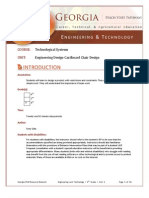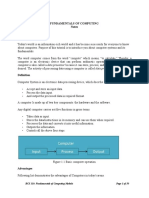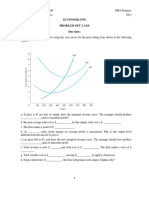Lesson Plan: Student Teacher Target in Relation To Standards and ITDP
Lesson Plan: Student Teacher Target in Relation To Standards and ITDP
Uploaded by
Annie HawkinsCopyright:
Available Formats
Lesson Plan: Student Teacher Target in Relation To Standards and ITDP
Lesson Plan: Student Teacher Target in Relation To Standards and ITDP
Uploaded by
Annie HawkinsOriginal Description:
Original Title
Copyright
Available Formats
Share this document
Did you find this document useful?
Is this content inappropriate?
Copyright:
Available Formats
Lesson Plan: Student Teacher Target in Relation To Standards and ITDP
Lesson Plan: Student Teacher Target in Relation To Standards and ITDP
Uploaded by
Annie HawkinsCopyright:
Available Formats
Lesson Plan
Student teachers Name: Lesson Number: 6 Annie Hawkins of 15 Date/Time: 01.05.13 Curriculum Area / Activity: Lesson Duration: Isometric city and PCB boards 1 hour KMA Number of Pupils: Class: 8a Dt1 KMA
SEN Pupils Number in lesson:
(refer to departmental register / IEPs)
Names of other adults present:
Student teacher target in relation to Standards and ITDP 7c manage classes effectively, using approaches which are appropriate to pupils needs in order to involve and motivate them 4a impart knowledge and develop understanding through effective use of lesson time Identified targets based upon previous lesson plan evaluation
Short activities to engage students Keep teacher talking to a minimum to encourage independent learning Have all resources ready before the lesson, check and double check When demonstrating so not stand in front of the machine
Learning Objectives
What do I intend the pupils to learn? (Knowledge, understanding, values, attitudes and skills) LO1 Students will learn about how the etch resist pen and etching tank work to produce a PCB Working towards... All students will understand what a track is and demonstrate their knowledge by drawing tracks on their PCB All students will add some detail to their isometric city following the grid
Differentiated Learning Outcomes
Achieving... Most students will understand what the process of etching a PCB consists of Beyond... Some students understand that the reason for drawing round the tracks is so that the copper can be connected to the component by soldering Some students will demonstrate their knowledge by creating different shapes throughout their city
LO2
Students will learn adding detail to their city by learning about different drawing techniques: crating and isometric
Most students will show crating in their city
Learning across the curriculum
Maths
Resources
BOB box Isometric grid paper Students folders Resistor homework (due today) 2mm drill bit
Time & Learning Objectives
Pupil Learning Activities
Including reference to inclusion strategies
Teaching Points / Strategies / Teacher Role
Including reference to how tasks have been differentiated
Organisation and Risk Assessment
Assessment for Learning Strategies
Formal and informal
5min
5min
30min
5min
10min
Students line up outside and come in when asked *Homework out to be handed in* While taking the register students write down three things that they might see in a city e.g. post boxes bridges street lamps etc Students will learn about the crating techniques to draw curved shapes in their city- they will briefly learn about proportion Students drill the larger 2mm holes in their PCB (two at a time one on the bench drill and one on the pillar drill) Students start to plan out detail in their Demo drawing with etch resist pen to draw the track- explain that any non-covered copper will be etched away in the etching tank All students etch resist their PCB
Students must say yes miss to the register.- take and send off register
Folders out on tables learning objectives written on board 1mm drill bit and box of bling PCB kit
Students will be assessed on their ability to contribute to class activities
Demo on the board of some of the detail that students have come up with using random name generator Drills set up (print out of two larger holes next to each drill so students can check which holes they are drilling) Students use techniques shown to add some detail in their city
Students gathered round the front of the room in front of the board
Students will be assessed on the detail they put into their isometric cities- for example curtains behind windows Students will be assessed on their ability to use techniques shown and their behaviour in the workshop
Power point 44 and 45 (44 printed out and put by drills)
5min
Input process output dance
Collect PCBs up to be etched for next lesson
Lesson Plan
Student teachers Name: Lesson Number: 7 Annie Hawkins of 15 Date/Time: 02.05.13 Curriculum Area / Activity: Lesson Duration: Isometric city and PCB boards 1 hour KMA Number of Pupils: Class: 8a Dt1 KMA
SEN Pupils Number in lesson:
(refer to departmental register / IEPs)
Names of other adults present:
Student teacher target in relation to Standards and ITDP 7c manage classes effectively, using approaches which are appropriate to pupils needs in order to involve and motivate them 4a impart knowledge and develop understanding through effective use of lesson time Identified targets based upon previous lesson plan evaluation
Learning Objectives
What do I intend the pupils to learn? (Knowledge, understanding, values, attitudes and skills) LO1 Students will learn how to join metals in a PCB using solder Working towards... All students will understand how to safely use a soldering iron with a holder, sponge, table protector.
Differentiated Learning Outcomes
Achieving... Most students will understand that the pad and the component need to be heated to ensure a good connection Beyond... Some students will understand that solder is used to join components to a PCB because it is a conductive metal with a melting point of 90120*C
LO2
Students will learn about the manufacture of PCBs- how to fix components in place securely, with good electrical connection and on the correct side of the board
All students will check their soldering to ensure a good connection
Most students will fix their components onto the correct side of the board
Some students will understand that a good solder joint means a good connection
Learning across the curriculum
Product design
Resources
Soldering iron box booked out
Time & Learning Objectives
Pupil Learning Activities
Including reference to inclusion strategies
Teaching Points / Strategies / Teacher Role
Including reference to how tasks have been differentiated
Organisation and Risk Assessment
Assessment for Learning Strategies
Formal and informal
5min
Students line up outside and come in when asked Students think about as many different types of joining techniques as they can. Are there different joining techniques for different materials? E.g. metal, wood, paper, plastics This will lead on to demo of joining components to a PCB Students will learn about the process of soldering components to a PCB Students will learn about the health and safety implications of using soldering irons (open windows, heat proof mats etc) Students fill in soldering process sheet so that they can refer to the sheet when soldering
Students must say yes miss to the register.- take and send off register
Folders out on tables learning objectives written on board 1mm drill bit and box of bling PCB kit
5min
Print out of soldering order to read to students, assign different students a different point to remember. Demo using webcam to show students how to solder successfully- heat up track and component leg. Give out etched PCBs Give guidance where necessary
Soldering iron with holder and moist sponge set up on teachers desk
5min
Students will be assessed on health and safety and their soldering
35min
10min
One table set up for soldering- one table at a time will solder the fixed resistor into their PCB All other students work on their isometric city Clear up and tidy away
BOB soldering box Risk assessment for soldering in the workshop
Random name generator- students must come up with a statement about what they have learned so far and another students decides if it is true or false
You might also like
- Edtpa Lesson PlanDocument2 pagesEdtpa Lesson Planapi-253469735No ratings yet
- Burton Morris CombinedDocument4 pagesBurton Morris Combinedapi-267993711No ratings yet
- Risk Assessment TextilesDocument2 pagesRisk Assessment TextilesAnnie HawkinsNo ratings yet
- Risk Assessment TextilesDocument2 pagesRisk Assessment TextilesAnnie HawkinsNo ratings yet
- Leson Plan Monday 3rd June 2013 8dtd4 AjoDocument2 pagesLeson Plan Monday 3rd June 2013 8dtd4 Ajoapi-259181310No ratings yet
- Copyofbuildingceramicsculpture KatherineoharaDocument7 pagesCopyofbuildingceramicsculpture Katherineoharaapi-323174859No ratings yet
- Maquette Lesson Plan Edwardsj 1Document3 pagesMaquette Lesson Plan Edwardsj 1api-524714561No ratings yet
- Lesson Plan: Learning Objectives Differentiated Learning OutcomesDocument4 pagesLesson Plan: Learning Objectives Differentiated Learning OutcomesAnnie HawkinsNo ratings yet
- 2 - SPA-Prerequisite Information Before Teaching (PIT)Document3 pages2 - SPA-Prerequisite Information Before Teaching (PIT)Astha SinghNo ratings yet
- Analysing Results of ExperimentsDocument5 pagesAnalysing Results of ExperimentsSimon Mauma EfangeNo ratings yet
- k-2 Color Zoo PlanDocument4 pagesk-2 Color Zoo Planapi-254413107No ratings yet
- Math Activity - Nov 13Document2 pagesMath Activity - Nov 13api-267007426No ratings yet
- Day 4 - Value IntroDocument3 pagesDay 4 - Value Introapi-354197556No ratings yet
- 9yitw 1Document3 pages9yitw 1api-322546683No ratings yet
- Lesson Plan: Student Teacher Target in Relation To Standards and ITDPDocument4 pagesLesson Plan: Student Teacher Target in Relation To Standards and ITDPAnnie HawkinsNo ratings yet
- My Session PlanDocument22 pagesMy Session PlanGindra RañosaNo ratings yet
- Fractions - Lesson PlanDocument6 pagesFractions - Lesson PlanYamunah KrishnanNo ratings yet
- Silk Screen PrintingDocument9 pagesSilk Screen PrintingSamuel Villa100% (1)
- M.T.W SampleDocument15 pagesM.T.W SampleSheldon MyvettNo ratings yet
- Maquette Lesson Plan Edwardsj 2Document3 pagesMaquette Lesson Plan Edwardsj 2api-524714561No ratings yet
- Two Day Lesson PlanDocument6 pagesTwo Day Lesson Planapi-271698696No ratings yet
- Syllabus Draw-Paint A 2018-19Document2 pagesSyllabus Draw-Paint A 2018-19api-396907491No ratings yet
- ENGR - 8-1 - UNIT PLAN Cardboard Chair DesignDocument10 pagesENGR - 8-1 - UNIT PLAN Cardboard Chair Designbc_dodNo ratings yet
- Lesson 1 - 1st Year MTWDocument5 pagesLesson 1 - 1st Year MTWapi-273345050100% (1)
- EDU 240 Lesson PlanDocument5 pagesEDU 240 Lesson Plandrd92No ratings yet
- Text Based Sculptures 3Document17 pagesText Based Sculptures 3api-250073958No ratings yet
- Grade 3 Science Individual Arches Lesson Plan 5Document6 pagesGrade 3 Science Individual Arches Lesson Plan 5api-264279988No ratings yet
- Needs AnalysisDocument2 pagesNeeds Analysisapi-334942575No ratings yet
- David Lindquist Cardboard Chair Lesson PlanDocument5 pagesDavid Lindquist Cardboard Chair Lesson PlanDavid LindquistNo ratings yet
- Syllabus: Section: 01 CRN: 30476Document5 pagesSyllabus: Section: 01 CRN: 30476Lucas AlmeidaNo ratings yet
- Ping Pong Lesson PlanDocument3 pagesPing Pong Lesson Planapi-300045305No ratings yet
- Daily Lesson Plan Mathematics Year 3Document6 pagesDaily Lesson Plan Mathematics Year 3Byt AzyraNo ratings yet
- B.tech 3RD Term YR7 PlanDocument25 pagesB.tech 3RD Term YR7 Planadegunloye temitopeNo ratings yet
- 9yitw 2Document4 pages9yitw 2api-322546683No ratings yet
- Measurement Year 6 7Document10 pagesMeasurement Year 6 7api-419109401No ratings yet
- Lesson Plan Pro-FormaDocument4 pagesLesson Plan Pro-FormaShealagh LyonsNo ratings yet
- Lesson Two For Online PortfolioDocument7 pagesLesson Two For Online Portfolioapi-267003417No ratings yet
- Effective Assessment: Assignment I: After Going Through The PaperDocument4 pagesEffective Assessment: Assignment I: After Going Through The PaperKashyap ChintuNo ratings yet
- Ramco Institute of Technology: Goals (Learning Outcomes)Document10 pagesRamco Institute of Technology: Goals (Learning Outcomes)kanakarajNo ratings yet
- Udl Lesson Plan - Ed 4702Document6 pagesUdl Lesson Plan - Ed 4702api-242345831No ratings yet
- UbD Lesson Plan For Podcasting LessonDocument8 pagesUbD Lesson Plan For Podcasting Lessonlilyrose6No ratings yet
- 2nd Grade Math 1 - Week 2Document6 pages2nd Grade Math 1 - Week 2api-507060080No ratings yet
- PCB Designing LPDocument3 pagesPCB Designing LPGlezelBayubayNo ratings yet
- Cylinders Lesson PlanDocument4 pagesCylinders Lesson Planmatthew_bottomsNo ratings yet
- The Role of Ceramics in Art History and Contemporary Art Will Be ExploredDocument12 pagesThe Role of Ceramics in Art History and Contemporary Art Will Be ExploredKelley_Eggert_800No ratings yet
- LP 032513 MathDocument3 pagesLP 032513 Mathapi-208643879No ratings yet
- Scsu Coeld Edtpa Lesson Plan Template 1 2Document7 pagesScsu Coeld Edtpa Lesson Plan Template 1 2api-741703342No ratings yet
- Lesson 1 - MathDocument3 pagesLesson 1 - Mathapi-306929216No ratings yet
- tp2 Scheme For 2nd Yr MTWDocument27 pagestp2 Scheme For 2nd Yr MTWapi-270673168No ratings yet
- Pythagorean Theorem B Layer - FeedbackDocument5 pagesPythagorean Theorem B Layer - Feedbackapi-278122461No ratings yet
- 10xgta 2Document4 pages10xgta 2api-322546683No ratings yet
- Resarch Lesson PlanDocument4 pagesResarch Lesson Planapi-254931477No ratings yet
- Mason High - Ceramics 2 - Centerpiece Lesson PlanDocument4 pagesMason High - Ceramics 2 - Centerpiece Lesson Planapi-267189611No ratings yet
- Tech AssignmentDocument9 pagesTech Assignmentapi-329258263No ratings yet
- Lesson Plan 1Document3 pagesLesson Plan 1api-257004281No ratings yet
- Gregg Lessonplan Dramatic Playpdf2Document4 pagesGregg Lessonplan Dramatic Playpdf2api-490421691No ratings yet
- InventorslpfullDocument8 pagesInventorslpfullapi-300148584No ratings yet
- LP 6th Grade Coiled Vessels 1 Lash 1Document12 pagesLP 6th Grade Coiled Vessels 1 Lash 1api-711870471No ratings yet
- Teaching Tools to Streamline Your Classroom and Engage Students (K-5): Through the Eyes of a TeacherFrom EverandTeaching Tools to Streamline Your Classroom and Engage Students (K-5): Through the Eyes of a TeacherRating: 5 out of 5 stars5/5 (1)
- Cape Communication Studies: Practical Exercises for Paper 02 EssaysFrom EverandCape Communication Studies: Practical Exercises for Paper 02 EssaysNo ratings yet
- Health and Safety Teaching PPT KS3Document13 pagesHealth and Safety Teaching PPT KS3Annie Hawkins100% (1)
- Lesson Plan: Student Teacher Target in Relation To Standards and ITDPDocument4 pagesLesson Plan: Student Teacher Target in Relation To Standards and ITDPAnnie HawkinsNo ratings yet
- H&S Manual West SussexDocument68 pagesH&S Manual West SussexAnnie Hawkins100% (1)
- Health and Safety Standards in D&TDocument9 pagesHealth and Safety Standards in D&TAnnie HawkinsNo ratings yet
- Building Bulletin 81Document191 pagesBuilding Bulletin 81Annie HawkinsNo ratings yet
- Machine Use Proforma Pillar DrillDocument1 pageMachine Use Proforma Pillar DrillAnnie HawkinsNo ratings yet
- 5 Steps To Risk AssessmentDocument8 pages5 Steps To Risk AssessmentAnnie Hawkins100% (1)
- DL079Document43 pagesDL079Annie HawkinsNo ratings yet
- Risk Assessment BufferDocument1 pageRisk Assessment BufferAnnie HawkinsNo ratings yet
- Acrylic ArtefactDocument1 pageAcrylic ArtefactAnnie HawkinsNo ratings yet
- Push SticksDocument1 pagePush SticksAnnie HawkinsNo ratings yet
- Pillar Drill ProformaDocument1 pagePillar Drill ProformaAnnie HawkinsNo ratings yet
- Computer Aided Manufacture: TasksDocument1 pageComputer Aided Manufacture: TasksAnnie HawkinsNo ratings yet
- ED505 Analysing Subject ConceptsDocument1 pageED505 Analysing Subject ConceptsAnnie HawkinsNo ratings yet
- Hexagon FinishingDocument1 pageHexagon FinishingAnnie HawkinsNo ratings yet
- Wine RackDocument1 pageWine RackAnnie HawkinsNo ratings yet
- The Analogies in GitaDocument6 pagesThe Analogies in GitaSivasonNo ratings yet
- Full Text IndexingDocument14 pagesFull Text IndexingBhanu AletiNo ratings yet
- 15 - Golden Week - Lesson NotesDocument4 pages15 - Golden Week - Lesson NotesnabucodonosoirNo ratings yet
- Appendix 1 SNC Annual Report Re-Issue Format AmendmentsDocument18 pagesAppendix 1 SNC Annual Report Re-Issue Format AmendmentsMaureen del RosarioNo ratings yet
- Meralco RatesDocument1 pageMeralco RatesnkeilNo ratings yet
- Ozoter EfficacyDocument7 pagesOzoter EfficacyHasanah EkaNo ratings yet
- Lesson 3 - Atomos, Aristotle and Alchemy (Chemistry Before Modern History)Document18 pagesLesson 3 - Atomos, Aristotle and Alchemy (Chemistry Before Modern History)Eji Alcoreza100% (1)
- India Trade With OpecDocument4 pagesIndia Trade With OpecgeorgepalexNo ratings yet
- Guitar Chord Bible Over 500 Illustrated Chords For Rock BlueDocument259 pagesGuitar Chord Bible Over 500 Illustrated Chords For Rock BlueAngel Villarreal100% (3)
- Shell Tellus S2 M 32: Performance, Features & BenefitsDocument9 pagesShell Tellus S2 M 32: Performance, Features & BenefitsGuntara WigunaNo ratings yet
- Fundamentals of Computing NotesDocument50 pagesFundamentals of Computing NotesKadima ChitechiNo ratings yet
- YgojDocument25 pagesYgojAnshul SainiNo ratings yet
- 5 Small Business Ideas in BangladeshDocument4 pages5 Small Business Ideas in BangladeshKushal PodderNo ratings yet
- Open Loop and Closed Loop SystemsDocument3 pagesOpen Loop and Closed Loop SystemsGilbert Sigala0% (1)
- AnisometropiaDocument49 pagesAnisometropiaRaissaNo ratings yet
- Attachee Assement ReportDocument11 pagesAttachee Assement Reportmarvelousmugari100% (1)
- Chapter 3 Science, Technology and Nation BuildingDocument13 pagesChapter 3 Science, Technology and Nation BuildingRaeNo ratings yet
- Hospital ResearchDocument28 pagesHospital ResearchtolentinojohnclarenceNo ratings yet
- BONUS Week 3 Homework - Fall 2021Document4 pagesBONUS Week 3 Homework - Fall 2021zuhair khanNo ratings yet
- Iodine, Zinc & CopperDocument17 pagesIodine, Zinc & CopperGanesh V GaonkarNo ratings yet
- Speech Nadal: Ger Federer Rafael Nadal Australian Open WimbledonDocument2 pagesSpeech Nadal: Ger Federer Rafael Nadal Australian Open WimbledonDaniel XizainasNo ratings yet
- Docs Scrapy Org en LatestDocument354 pagesDocs Scrapy Org en LatestCesar Marinho EirasNo ratings yet
- The Cambridge History of Classical Literature: P. E. EasterlingDocument121 pagesThe Cambridge History of Classical Literature: P. E. EasterlingMusic For All SoaresNo ratings yet
- Problem Set 1 (Unit I)Document10 pagesProblem Set 1 (Unit I)Prashant Kumar ShuklaNo ratings yet
- QB AlgebraLogQuadraticProgressionDocument12 pagesQB AlgebraLogQuadraticProgressionIshhuNo ratings yet
- Articles of Incorporation GreenDocument14 pagesArticles of Incorporation GreenMarkus AureliusNo ratings yet
- Maths 9 (First Two Weeks)Document34 pagesMaths 9 (First Two Weeks)AngelNo ratings yet
- Economics PG Problem Set 2 Ans Due DateDocument15 pagesEconomics PG Problem Set 2 Ans Due DateHuỳnh LinhNo ratings yet
- BS en 50119-2009+A1-2013 Electric Traction OLEDocument94 pagesBS en 50119-2009+A1-2013 Electric Traction OLEMaría Hidalgo MurilloNo ratings yet
- Assessment 2: Answer: YesDocument6 pagesAssessment 2: Answer: YesSahil GoyalNo ratings yet









































































































